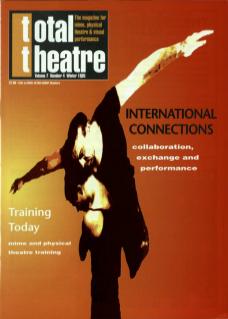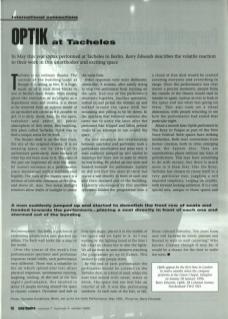Tacheles is no ordinary theatre. The outside of the building looks as though it is falling to bits. It is huge, made up of at least three blocks in one of Berlin's main streets. With rusting ghost-like reminders of its origins as a department store and cinema, it is about as far removed from an eighties model of an up-market arts centre as it is possible to get. It is dirty, dusty, bare. In the open, turbulent and above all public atmosphere of this street, this building, this place called Tacheles, Optik was to find a unique arena for its work.
The theatre itself is on the first floor, the site of the original cinema. It is an amazing space, not by virtue of its architecture particularly, more because of what has not been done to it. The signs of the past are imprinted all over the space. Its current existence as a performance space maintained with a sophisticated fragility. The floor of the theatre space is a mixture of concrete, remnants of flooring, and above all, dust. Two metal skylight windows allow shafts of sunlight to pierce the atmosphere. The walls, a patchwork of crumbling plasterwork and patched up pillars. The back wall looks like a map of the world.
Over the course of the week's five performances spectator and performer responses varied wildly, each performance very different. There was a volatility in the air which spilled over into direct physical responses, spontaneous running, laughing, smiling. At the end of the first night's performance, this resulted in about 15 people moving around the space in chaotic contact. Dyonisiac and daft at the same time.
A man suddenly jumped up and started to demolish the front row of seats and headed towards the performers... placing a seat directly in front of each one and stormed out of the building
Other responses were more deliberate, clown-like. A woman, after vainly trying to stop two performers from running on the spot, tied one of the performer's shoelaces together. Another spectator rushed in and picked the woman up and walked around the space with her screaming and yelling to be let down. In the mayhem that followed someone else came out to untie the laces after the performer had tripped and fallen several times in an attempt to run round the space.
On one occasion the relationship between spectator and performer took a particularly provocative and tense turn. A man suddenly jumped up and started to demolish the front row of seats in which he was sitting. He picked up two seats and headed towards the performers. Luckily he did not hurl the seats at them but placed a seat directly in front of each one and then stormed out of the building, Evidently encouraged by this another spectator folded his programme into a little tent shape, placed it in the middle of the space and set light to it. As I was waiting by the lighting board at the time I felt I had no choice but to dim the lights. We all sat there in semi-darkness watching the programme go up in flames. This seemed to calm people down.
By the end of each performance the performers would be covered in the Tacheles dust, or a kind of mud, where the dust had mixed with sweat, water or drink. The space did not feel like an interior at all, it was like performing outdoors. At each turn of the feet, or fall, a cloud of fine dust would be created covering everyone and everything in range. Once the performance was over (never a precise moment), people from the outside of the theatre would start to wander in again, curious as ever to look at the space and see what was going on there. This also took on a ritual dimension, with people returning to see how the performance had ended that particular night.
About a month later Optik performed in The Roxy in Prague as part of the New Wave Festival. Both spaces have striking similarities. Both were conversions from former cinemas, both in cities emerging from the Eastern bloc. They are unpretentious places without any trace of prettification. This may have something to do with money, but there is much more to it than that. Like the Roxy, Tacheles has chosen to create itself in a very particular way, juggling a self-imposed simplicity, verging on crudity, with forward looking ambition. It is a very special mix, unique to those spaces and those cultural histories. Ten years from now will Tacheles be newly painted and floored in wall to wall carpeting? Who knows. Cleaner though it may be, it would be a shame for the dust to settle too soon.
Optik appear for the first time in London in twelve months when the company performs at the Union Chapel, Islington on Sunday 28 January 1996.

